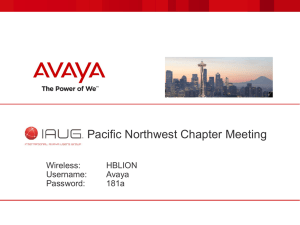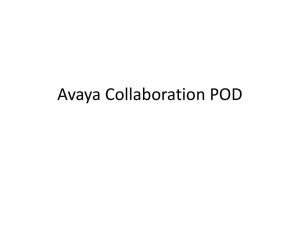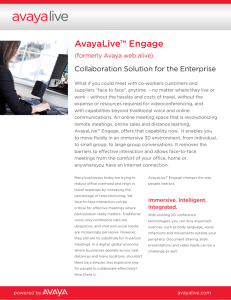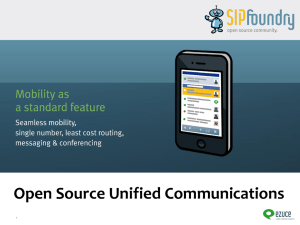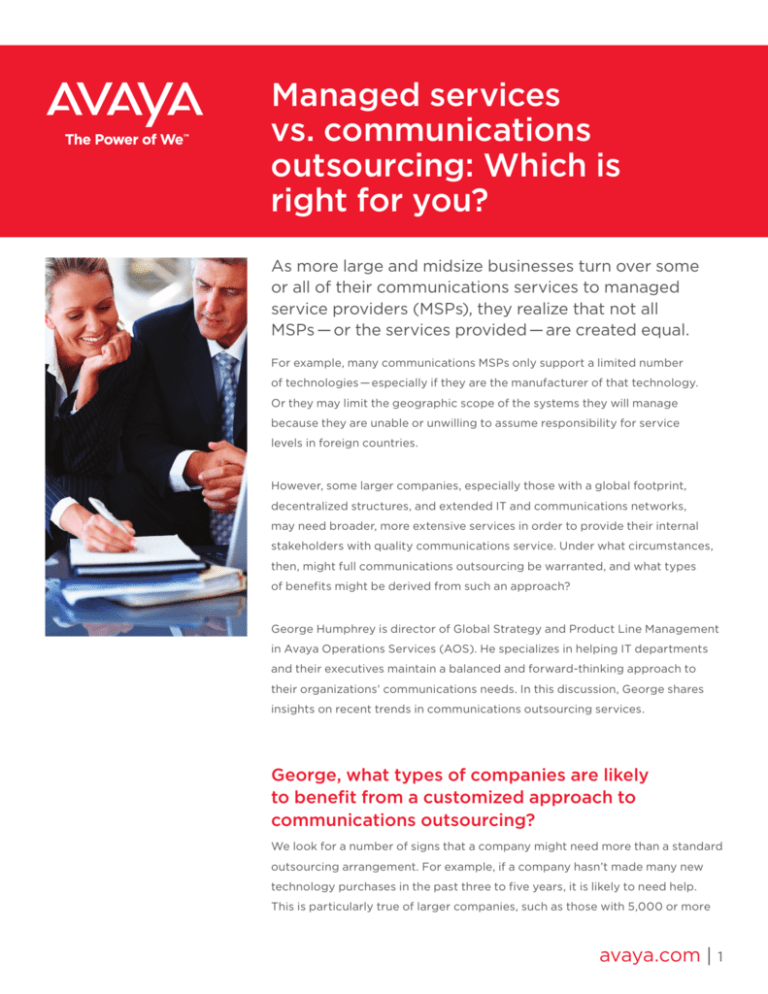
Managed services
vs. communications
outsourcing: Which is
right for you?
As more large and midsize businesses turn over some
or all of their communications services to managed
service providers (MSPs), they realize that not all
MSPs — or the services provided — are created equal.
For example, many communications MSPs only support a limited number
of technologies — especially if they are the manufacturer of that technology.
Or they may limit the geographic scope of the systems they will manage
because they are unable or unwilling to assume responsibility for service
levels in foreign countries.
However, some larger companies, especially those with a global footprint,
decentralized structures, and extended IT and communications networks,
may need broader, more extensive services in order to provide their internal
stakeholders with quality communications service. Under what circumstances,
then, might full communications outsourcing be warranted, and what types
of benefits might be derived from such an approach?
George Humphrey is director of Global Strategy and Product Line Management
in Avaya Operations Services (AOS). He specializes in helping IT departments
and their executives maintain a balanced and forward-thinking approach to
their organizations’ communications needs. In this discussion, George shares
insights on recent trends in communications outsourcing services.
George, what types of companies are likely
to benefit from a customized approach to
communications outsourcing?
We look for a number of signs that a company might need more than a standard
outsourcing arrangement. For example, if a company hasn’t made many new
technology purchases in the past three to five years, it is likely to need help.
This is particularly true of larger companies, such as those with 5,000 or more
avaya.com | 1
communications ports and 500 or more contact center seats. It really doesn’t
matter what industry they’re in, companies in this situation typically have been
focused on cost containment and cash flow since the recession. Because there
is still so much economic uncertainty, they may want to make investments in
their IT and communications infrastructures, but cost and capital expense
pressures often prevent it.
Organizational change is another common factor behind a company’s
decision to outsource. Whether it’s downsizing, expansion, reorganization,
merger or acquisition, when companies undertake major changes, their IT
functions may struggle to provide appropriate unified communications and
contact center resources to the business units. This often happens when
the corporate transformation involves cost-cutting and other resource
reductions — there simply aren’t enough resources to go around.
Conversely, in the case of aggressive business growth, IT departments are
often compelled to expand their capabilities without corresponding budget
and capital allocation increases. The business units they serve still need
responsive IT and communications capabilities, but the resources necessary
to provide them may be constrained.
Another common barrier is multivendor environments. As businesses grow,
especially through M&A, we often see a wide variety of technologies that are,
at best, cobbled together. Managing such a diverse environment, especially
as companies migrate from time division multiplexing (TDM) systems toward
modern standards, such as Session Initiation Protocol (SIP)-enabled environments,
there simply may be too many gaps and complexities to overcome. This issue
is often compounded as companies expand, because a growing internal user
base often demands higher performance and higher availability. Delivering
those improvements may simply not be possible in an environment that
already struggles with interoperability issues.
What benefits can companies gain from
communications outsourcing?
Cost savings, performance improvements, faster migration to new technologies
and customized service level agreements are a few of the benefits that companies
enjoy when they outsource.
avaya.com |
2
From a cost perspective, we look at it several ways. Today, most large
businesses typically see a reduction in operating costs of between 20 and
35 percent1 when they outsource. The reduction in total cost of ownership
(TCO) can be between 15 and 20 percent. These reductions are achieved by
moving from a capital expenditure model to a “utility pricing” or operating
expense model whereby all costs are built into a per-seat or per-port formula.
Such a model gives clients significantly greater flexibility in how they structure,
deploy and pay for their communications services, as well as the confidence
of having a predictable cost per month.
An operating expense
model gives clients
significantly greater
flexibility in how they
structure, deploy
and pay for their
communications
services, as well as
the confidence of
having a predictable
cost per month.
Outsourcing also offers clients significantly improved performance across
their communications infrastructure. As with other IT outsourcing
environments, a leading outsourcing service provider should be making
continual investments in the latest technologies, especially in automated,
remote system diagnostics and monitoring. Even many larger businesses
have trouble making ongoing investments in these types of technologies.
By leveraging the investment of the service provider, clients gain access to
those capabilities without incurring the brunt of the investment.
Along the same lines, when companies are focused on cost-avoidance,
as is often the case in today’s turbulent economy, they may miss out on
opportunities to be first-adopters of new technologies­ — technologies
that may give them a competitive advantage over latecomers. A leading
outsourcing service provider should be making those investments as part
of its business strategy. So when the client pursues a communications
outsourcing arrangement, one important objective should be to leverage
those new technologies and make faster progress to “the next level.”
Finally, a leading practice in communications outsourcing arrangements is
giving clients flexible, global service level agreements with remediation. This
means that the service provider is so confident of the quality of service it can
provide that it is willing to guarantee service levels. If the service provider is
willing to offer such arrangements, clients should consider it a very good sign.
“Explosive Growth Predicted in IT Managed Service Industry,” globalservicesmedia, 2010,
http://microsites.globalservicesmedia.com/rimbeta/show.article.asp?5D115D565C115E.
1
avaya.com |
3
What are other factors to consider for a
communications outsourcing arrangement?
First, you want to look for a communications outsourcing provider that is
focused on more than the network. A leading practice going forward will
be taking a more holistic view of enterprise communications that includes
the applications that sit on top of the network. The network continues to
be important, of course, but the applications are what carry a business into
the future, enabling the workforce to create value and continually improve
operational performance. Under a communications outsourcing arrangement,
the service provider should be willing to sit with you on a regular basis and
identify new opportunities for unified communications and contact center
applications to support the business. The provider should understand those
applications and how they work in your business setting. And it should be
able to quickly devise a road map that shows you how to get from your
current environment to the “to-be” state.
Which brings up another issue — multivendor environments. Service providers
that only address part of your problem actually become part of the problem.
Your communications service provider should be able to assume responsibility
for whatever solutions are in place, and within a reasonable time frame move
you onto the platform and individual capabilities that you envision for the future
of your organization. The provider should be able to provide ITIL-compliant
services globally, regardless of the technologies involved. And it should
support advanced performance management by using best-in-class processes
and tools, such as advanced diagnostics, monitoring and ticketing.
Your communications service provider should be able to walk you through a
proactive methodology that it uses to ensure continuous service improvement,
performance optimization and employee productivity improvements. Your
outsourcing arrangement should include customized help desk services,
e-bonding, change management and overall client process integration.
If the provider hesitates on any of these — or has a blank look when you
ask about them — it should be a red flag.
Bottom line, when you move to a communications outsourcing arrangement,
the solution should adapt itself to your organization — not the other way around.
You should be confident that you’ll have a predictable cost and reliable levels
of service in the future and, at the same time, the flexibility to upgrade to new
technologies and new capabilities when they become available.
avaya.com |
4
About Avaya
Avaya is a global provider of business collaboration and communications solutions,
providing unified communications, contact centers, data solutions and related services
to companies of all sizes around the world. For more information, please visit
www.avaya.com.
About the author
George Humphrey is director of Global Strategy and Product Line Management in
Avaya Operations Services (AOS). In this role, he helps IT departments and their
executives maintain a balanced and forward-thinking approach to their organizations’
communications needs.
About Avaya Communications Outsourcing
Services (COS)
Through Avaya COS, we support the day-to-day operations of a client’s existing
communications infrastructure and manage what is currently in place. We help
design, plan and upgrade the client’s communications environment to meet their
future needs with a solution specifically designed for them. In COS arrangements,
Avaya guarantees customer service levels and price points with remediation.
Learn more
To learn more about Avaya Communications Outsourcing Services, please contact
your Avaya Account Manager or Authorized Partner or visit us at www.avaya.com.
© 2011 Avaya Inc. All rights reserved.
Avaya and the Avaya logo are trademarks of Avaya Inc. and are registered in the United States and other countries. All
trademarks identified by ®, ™ or SM are registered marks, trademarks and service marks, respectively, of Avaya Inc. All other
trademarks are the property of their respective owners. Avaya may also have trademark rights in other terms used herein.
References to Avaya include the Nortel Enterprise business, which was acquired as of December 18, 2009.
09/11 • SVC4805
avaya.com | 5

